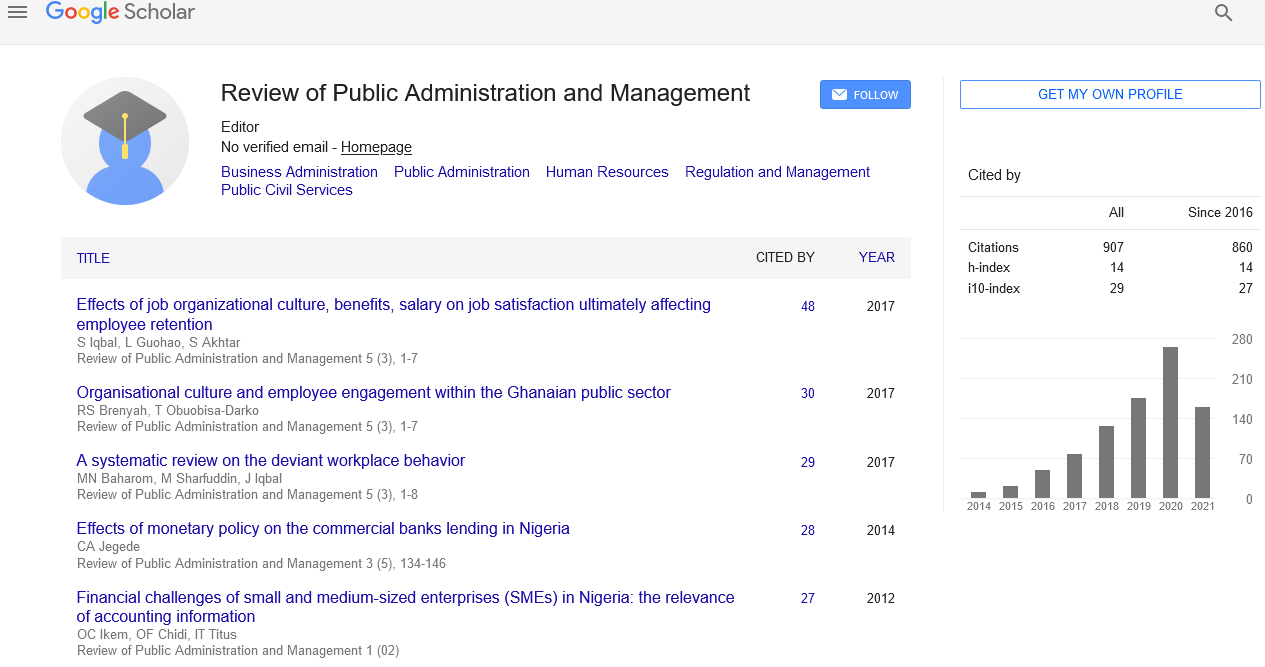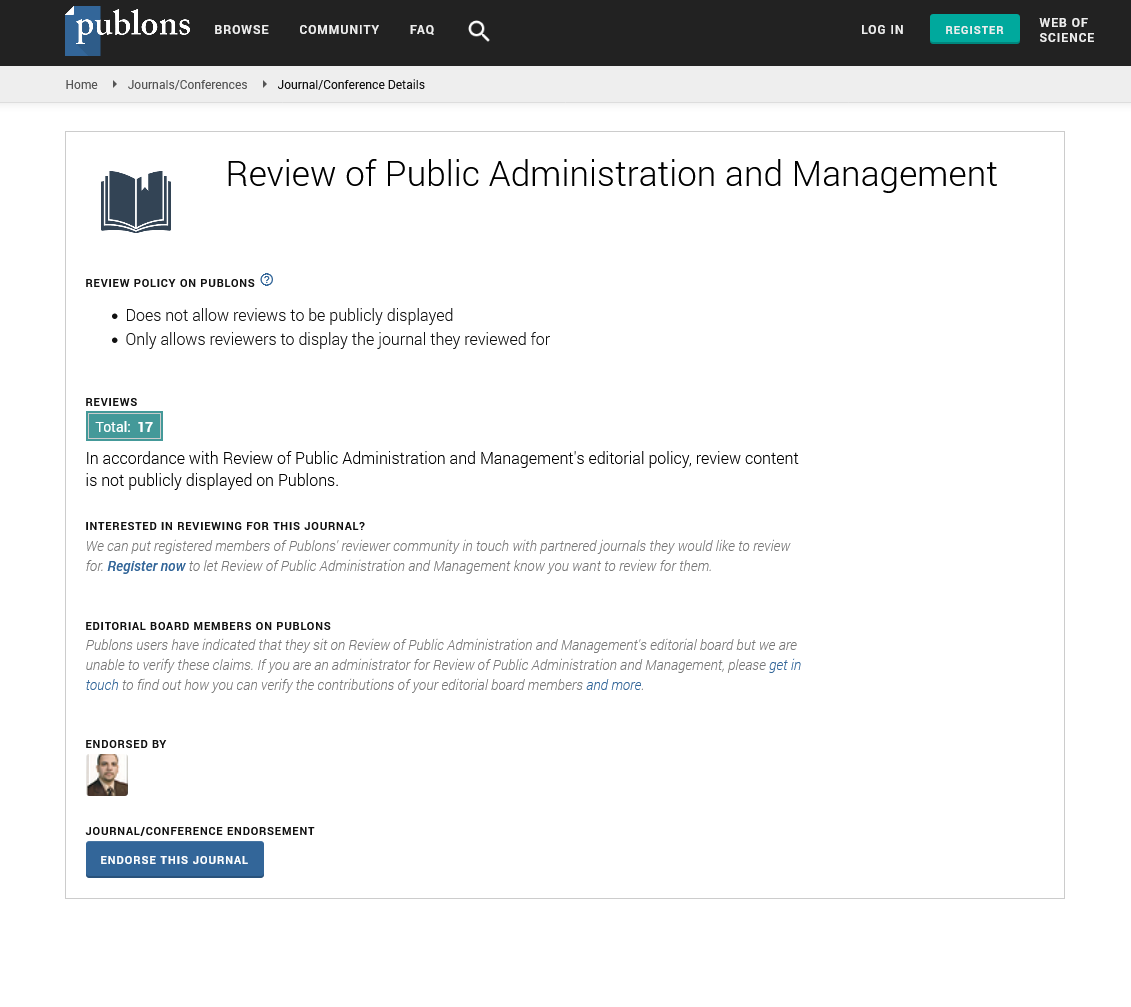Indexed In
- CiteFactor
- RefSeek
- Directory of Research Journal Indexing (DRJI)
- Hamdard University
- EBSCO A-Z
- Scholarsteer
- Publons
- Euro Pub
- Google Scholar
Useful Links
Share This Page
Journal Flyer

Open Access Journals
- Agri and Aquaculture
- Biochemistry
- Bioinformatics & Systems Biology
- Business & Management
- Chemistry
- Clinical Sciences
- Engineering
- Food & Nutrition
- General Science
- Genetics & Molecular Biology
- Immunology & Microbiology
- Medical Sciences
- Neuroscience & Psychology
- Nursing & Health Care
- Pharmaceutical Sciences
Commentary - (2025) Volume 13, Issue 1
AI Integration in Public Administration: Enhancing Transparency and Efficiency
Markus Vogel*Received: 24-Feb-2025, Manuscript No. RPAM-25-29216; Editor assigned: 26-Feb-2025, Pre QC No. RPAM-25-29216; Reviewed: 12-Mar-2025, QC No. RPAM-25-29216; Revised: 18-Mar-2025, Manuscript No. RPAM-25-29216; Published: 26-Mar-2025, DOI: 10.35248/2315-7844.25.13.474
Description
Artificial Intelligence (AI) is rapidly transforming the landscape of public administration, offering new possibilities for improving efficiency, transparency and service delivery in government operations. As global demand for faster, more responsive and accountable governance grows, AI technologies such as machine learning, natural language processing, predictive analytics and robotic process automation are being increasingly adopted by public institutions. These technologies are enabling governments to automate routine tasks, analyze vast amounts of data, detect patterns of inefficiency or corruption and make informed decisions with greater accuracy. The integration of AI in public administration signifies a shift toward data-driven governance, where intelligent systems assist in policymaking, service delivery and regulatory oversight. This transformation not only improves internal administrative performance but also enhances the citizen experience by making government services more accessible, timely and transparent.
One of the most significant impacts of AI in public administration is its potential to streamline administrative processes. Traditional bureaucratic systems are often characterized by delays, paperwork, redundancies and human errors. AI-powered automation tools can handle repetitive tasks such as data entry, form processing, appointment scheduling and application verification, thus reducing operational bottlenecks and freeing up human resources for more strategic functions. For instance, chatbots and virtual assistants are being used by government departments to handle citizen queries, process service requests and guide users through digital portals. These AI solutions not only reduce response times but also provide round-the-clock service, significantly improving the efficiency and reach of public institutions.
AI also plays a critical role in enhancing transparency and combating corruption in public administration. Through real-time monitoring and pattern recognition, AI systems can detect anomalies and flag suspicious activities in financial transactions, procurement processes, or resource allocations. Predictive analytics can be used to identify areas at high risk of fraud or misuse, enabling proactive audits and investigations. Additionally, AI-based systems can ensure compliance with regulations by automatically tracking deviations and generating alerts for policy violations. For example, in tax administration, AI tools can cross-check declarations with other data sources to identify discrepancies and reduce tax evasion. This level of scrutiny and automation contributes to building trust in government operations, as it minimizes human discretion and subjectivity in decision-making.
Data management is another domain where AI brings substantial improvements. Government agencies handle vast volumes of data related to health, education, social welfare, infrastructure and more. However, this data often remains underutilized due to lack of analytical capacity. AI systems can process large datasets quickly, identify trends and provide actionable insights for evidence-based policy formulation. In public health, for instance, AI tools have been used to track disease outbreaks, model health interventions and allocate medical resources efficiently. Similarly, in urban planning, AI can analyze demographic, geographic and mobility data to design smarter, more sustainable cities. These applications demonstrate how AI not only enhances operational efficiency but also strengthens policy effectiveness by enabling informed decision-making.
Despite these advantages, integrating AI into public administration is not without challenges. One of the primary concerns is the ethical and responsible use of AI. Decisions made or influenced by AI systems must be fair, unbiased and explainable. However, AI algorithms often operate as “black boxes,” where the rationale behind a decision is not transparent to users or affected individuals. This lack of interpretability can undermine public trust and accountability, especially in sensitive areas like law enforcement, welfare eligibility, or immigration decisions. To address this, governments must prioritize algorithmic transparency, establish clear governance frameworks and ensure that AI systems are subject to human oversight and regular evaluation.
Another critical challenge is data privacy and security. AI systems require large amounts of data to function effectively, but collecting and processing this data can raise serious privacy concerns. Without robust safeguards, personal data could be misused or leaked, violating citizens’ rights and eroding public confidence. Therefore, the integration of AI in government must be accompanied by strong data protection policies, cybersecurity measures and legal standards that define how data is collected, stored and used. Public sector organizations must also conduct risk assessments and impact evaluations before deploying AI tools to ensure they align with ethical norms and legal obligations.
The issue of digital inequality must also be considered. Not all citizens have equal access to digital infrastructure, devices, or literacy. AI-powered public services that are accessible only online may inadvertently exclude vulnerable or marginalized groups. To ensure inclusivity, governments need to design user-friendly AI interfaces, provide multilingual and offline alternatives and invest in digital literacy programs. The goal should be to create AI systems that enhance access, not create new barriers. Capacity building within the public sector is equally important. Integrating AI requires not only technological investments but also organizational transformation. Civil servants need to understand how AI works, how to manage it and how to interpret its outputs. This calls for interdisciplinary training programs, partnerships with technology providers and the creation of specialized roles for AI governance within government structures. Additionally, public agencies must foster a culture of innovation and experimentation, where the use of emerging technologies is encouraged but closely monitored for risks.
Citation: Vogel M (2025). AI Integration in Public Administration: Enhancing Transparency and Efficiency. Review Pub Administration Manag.13: 474.
Copyright: © 2025 Vogel M. This is an open access article distributed under the terms of the Creative Commons Attribution License, which permits unrestricted use, distribution and reproduction in any medium, provided the original author and source are credited.


